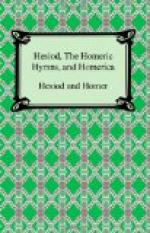PREFACE
This volume contains practically all that remains of the post-Homeric and pre-academic epic poetry.
I have for the most part formed my own text. In the case of Hesiod I have been able to use independent collations of several MSS. by Dr. W.H.D. Rouse; otherwise I have depended on the apparatus criticus of the several editions, especially that of Rzach (1902). The arrangement adopted in this edition, by which the complete and fragmentary poems are restored to the order in which they would probably have appeared had the Hesiodic corpus survived intact, is unusual, but should not need apology; the true place for the “Catalogues” (for example), fragmentary as they are, is certainly after the “Theogony”.
In preparing the text of the “Homeric Hymns” my chief debt — and it is a heavy one — is to the edition of Allen and Sikes (1904) and to the series of articles in the “Journal of Hellenic Studies” (vols. xv.sqq.) by T.W. Allen. To the same scholar and to the Delegates of the Clarendon Press I am greatly indebted for permission to use the restorations of the “Hymn to Demeter”, lines 387-401 and 462-470, printed in the Oxford Text of 1912.
Of the fragments of the Epic Cycle I have given only such as seemed to possess distinct importance or interest, and in doing so have relied mostly upon Kinkel’s collection and on the fifth volume of the Oxford Homer (1912).
The texts of the “Batrachomyomachia” and of the “Contest of Homer and Hesiod” are those of Baumeister and Flach respectively: where I have diverged from these, the fact has been noted.
Hugh G. Evelyn-White,
Rampton, NR. Cambridge.
Sept. 9th, 1914.
INTRODUCTION
General
The early Greek epic — that is, poetry as a natural and popular, and not (as it became later) an artificial and academic literary form — passed through the usual three phases, of development, of maturity, and of decline.
No fragments which can be identified as belonging to the first period survive to give us even a general idea of the history of the earliest epic, and we are therefore thrown back upon the evidence of analogy from other forms of literature and of inference from the two great epics which have come down to us. So reconstructed, the earliest period appears to us as a time of slow development in which the characteristic epic metre, diction, and structure grew up slowly from crude elements and were improved until the verge of maturity was reached.
The second period, which produced the “Iliad” and the “Odyssey”, needs no description here: but it is very important to observe the effect of these poems on the course of post-Homeric epic. As the supreme perfection and universality of the “Iliad” and the “Odyssey” cast into oblivion whatever pre-Homeric poets had essayed, so these same qualities exercised a paralysing




